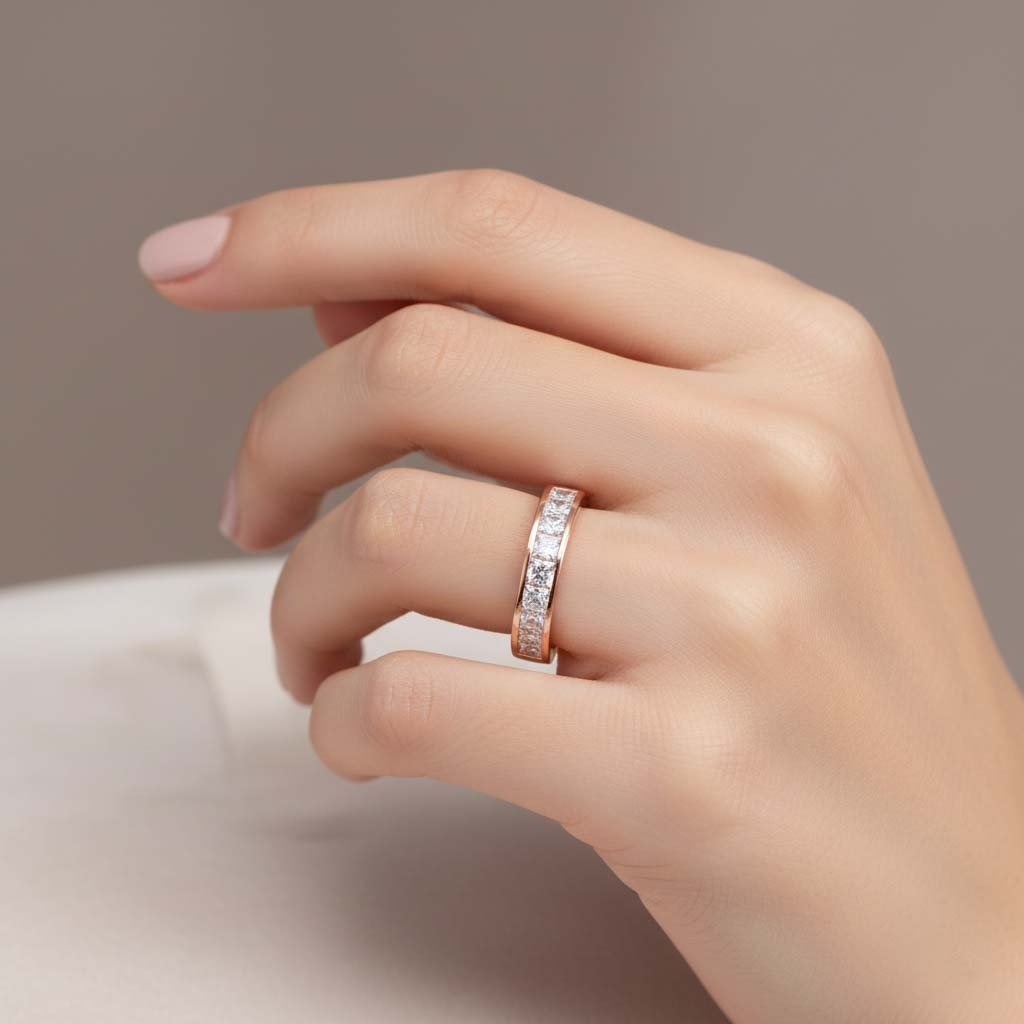Lab-created diamonds present significant value, offering quality comparable to natural diamonds but at a reduced price. They are also sourced ethically, appealing to those in search of sustainable and cost-effective alternatives to conventional diamonds.
For consumers navigating the diamond market, it’s crucial to keep abreast of changes, especially with the rise of lab-grown diamonds.
Known also as synthetic or cultured diamonds, these are genuine diamonds produced in controlled lab settings. This method accelerates the natural diamond formation process, accomplishing in much less time what takes nature millions of years.
The popularity of lab-grown diamonds is on the rise, primarily due to their cost-effectiveness. They can be priced as much as 40 to 50 percent lower than mined diamonds of similar size and quality.
Table of contents
Value in the world of diamonds extends beyond the initial purchase price, and this is particularly evident in the context of lab-grown diamonds.
These diamonds boast the same physical, chemical, and optical characteristics as their mined counterparts. However, it is generally recognized that lab-grown diamonds do not maintain the same resale value as natural diamonds.
Several factors influence this scenario, including the more cost-effective production methods and the fluctuating pricing models that reflect technological improvements in their manufacture.
In assessing the value of lab-grown diamonds, it is crucial to consider not only their market perception and the quality they deliver but also their increasing importance to consumers who value ethical and sustainable practices.
Thus, the concept of value with lab-grown diamonds encompasses not just financial aspects but also personal and ethical considerations, underscoring the broader significance of these gems in aligning with the consumer’s individual values and preferences.
Exploring the Fundamentals of Lab-Created Diamonds
Delving into Lab-Created Diamonds: Composition, Creation, and Comparison
What Are Lab-Created Diamonds?
Lab-created diamonds are genuine diamonds that are produced in controlled laboratory settings using sophisticated technology. Despite being manufactured, these diamonds share identical physical, chemical, and optical characteristics with natural diamonds mined from the earth.
The Science Behind Their Creation: HPHT and CVD
The creation of synthetic diamonds primarily relies on two technologies: High-Pressure High-Temperature (HPHT) and Chemical Vapor Deposition (CVD).
- HPHT Process:
- Utilizes extreme pressure and high temperatures.
- Transforms carbon into diamond by replicating conditions similar to those under the Earth’s crust.
- CVD Process:
- Grows diamond crystals layer by layer.
- Uses a hydrocarbon gas mixture, commonly methane, in a controlled environment.
Comparing Lab-Created and Natural Diamonds
| Aspect | Lab-Created Diamonds | Natural Diamonds |
|---|---|---|
| Origin | Produced in labs with advanced technologies. | Naturally formed in the Earth’s mantle over millennia. |
| Composition | Chemically identical to natural diamonds, consisting of pure carbon in an isometric crystal system. | Same pure carbon composition in an identical crystal structure. |
| Formation Time | Can be created within weeks to months. | Form over millions to billions of years. |
| Cost | Typically more affordable due to controlled production costs. | Priced based on rarity, size, and quality factors. |
| Environmental Impact | Often viewed as more environmentally sustainable due to minimal ecological disruption. | Associated with significant environmental concerns, including habitat destruction and emissions. |
| Market Perception | Increasingly seen as a sustainable and ethical alternative. | Cherished for their natural rarity and traditional appeal. |
In examining lab-grown diamonds, the focus is on understanding their nature, the innovative technologies behind their creation, and how they measure up to natural diamonds. This comprehensive view helps clarify why these man-made gems are becoming a preferred choice for many who prioritize sustainability without compromising on quality or beauty.
The primary distinctions between lab-grown and natural diamonds lie in their origins and cost.
Lab-created diamonds generally cost about 30-40% less than natural diamonds due to differences in their production processes. Although both types of diamonds exhibit the same crystal structure and external appearance, lab-grown diamonds tend to have a lower resale value.
Price:
- Lab-grown: Typically around $1,200 per carat.
- Natural: Roughly $4,200 per carat.
- Resale Value: Generally lower for lab-created diamonds.
Both High-Pressure High-Temperature (HPHT) and Chemical Vapor Deposition (CVD) diamonds appeal to those looking for responsibly sourced diamonds that do not sacrifice the gem’s brilliance or structural integrity.
In this guide, I will take you through the key elements of evaluating the quality of lab-grown diamonds and the crucial role of certification. These components are vital for understanding their worth and ensuring your purchase is well-informed.
Assessing the 4Cs: Cut, Color, Clarity, Carat
- Cut: The quality of a diamond’s cut is paramount in determining its brilliance and scintillation. Lab-grown diamonds are available in various cut qualities, with superior cuts offering the best sparkle and light performance.
- Table of Common Diamond Cuts:
- Round Brilliant: Optimizes light reflection.
- Princess: Provides a contemporary appearance with effective light scattering.
- Cushion: Features a square shape with rounded edges for a soft, pillow-like appearance.
- Color: The color of a diamond affects both its look and its market value. Lab-grown diamonds are graded on a color scale, with D (colorless) being the highest and most prized.Color Grading Scale:
- D-F: Colorless
- G-J: Near-colorless
- K-M: Slight yellow tint
- Clarity: Clarity measures the presence of internal and external flaws. A diamond with fewer inclusions and blemishes is considered more desirable and typically commands a higher price.Prominent Clarity Grades:
- FL: Flawless
- IF: Internally Flawless
- VVS1-VVS2: Very Very Slightly Included
- VS1-VS2: Very Slightly Included
- SI1-SI2: Slightly Included
- Carat: Refers to the weight of the diamond and is a significant factor in determining its price. While higher carat weights are generally more expensive, the cut, color, and clarity also play critical roles in its overall value.
Certification Authorities: Reputable organizations such as the GIA and IGI provide certifications that verify the quality and characteristics of diamonds, ensuring authenticity and trust in your purchase.
GIA (Gemological Institute of America): Esteemed for its meticulous grading systems, a GIA report on a lab-grown diamond indicates a trustworthy evaluation.
IGI (International Gemological Institute): Recognized for providing precise certificates for lab-grown diamonds, an IGI certificate is considered an authoritative assessment of the diamond’s quality attributes.
Comparing Certificates:
- GIA: Assigns a unified grade for clarity and color.
- IGI: Delivers detailed grades for each characteristic of quality.
Additional respected certification organizations include the Gem Certificate and Assurance Lab (GCAL). While each entity maintains distinct grading standards, their collective goal is to authentically assess the diamond’s quality.
Understanding the Importance of Appraisals
An appraisal provides a professional estimation of a diamond’s value, crucial for insurance coverage and potential resale.
Despite their generally lower resale value, lab-grown diamonds should be appraised based on:
- Quality Parameters:
- Evaluation of the 4Cs
- Details from certifications
The appraisal indicates the diamond’s present market value, which might not always correlate with the initial purchase price, particularly for lab-grown diamonds, which may depreciate more significantly than natural diamonds.
Market Trends and Value Proposition
| Diamond Type | Average Price Range | Factors Influencing Price |
|---|---|---|
| Natural Diamonds | $3,200 – $20,000+ per carat | Quality (Cut, Color, Clarity, Carat Weight), Rarity, Market Demand, Certification |
| Lab-Grown Diamonds | $800 – $8,000 per carat | Quality (Cut, Color, Clarity, Carat Weight), Production Costs, Market Demand, Certification |
This segment explores the dynamic landscape of the lab-grown diamond market, shedding light on its demand, supply dynamics, pricing disparities vis-à-vis natural diamonds, and the factors shaping their resale value and depreciation.
Demand and Supply of Lab-Grown Diamonds
The allure of lab-grown diamonds has been steadily increasing, propelled by a heightened consumer consciousness and a quest for ethically sourced alternatives.
By 2021, the market valuation of lab-grown diamonds had soared significantly, with projections indicating a continued surge in market share until 2030.
This burgeoning demand is met by cutting-edge production techniques like Chemical Vapor Deposition (CVD), which are continuously evolving to enhance efficiency and positively influence the supply chain.
Price Comparison with Natural Diamonds
Lab-grown diamonds typically present a more economical option compared to their natural counterparts.
For instance, a 1.00 carat lab-grown diamond may be priced at $1,340, while a natural diamond of the same weight could command a staggering $152,210.
These figures underscore two key observations:
- Price per Carat: Lab-grown diamonds are notably more budget-friendly.
- Price Range: Both markets cater to a diverse spectrum of budgets, offering options for various consumer preferences.
Understanding Resale Value and Depreciation
In the realm of resale, lab-grown diamonds often do not retain their value as effectively as natural diamonds.
For buyers with investment-oriented inclinations, the enduring value retention of natural diamonds has historically been a pivotal consideration. However, the accessibility of lab-grown alternatives, with their lower upfront costs and ethical appeal, is increasingly resonating with consumers prioritizing immediate savings and conscientious choices.
When delving into diamond choices, several key elements come into consideration. It’s essential to assess what matches personal requirements, moral principles, and financial constraints. In this sphere, lab-created diamonds offer intriguing pathways as both an economical and ethical substitute to naturally occurring ones.
Selecting the Ideal Diamond to Suit Your Preferences
Narrowing down the perfect diamond can pose a dilemma. Every shopper holds distinct inclinations regarding dimensions, shape, hue, and purity. Unlike their naturally formed counterparts, lab-grown diamonds provide a level of precision and consistency.
My primary focus revolves around familiarizing myself with the diamond grading criteria. This framework typically applies to both mined and lab-grown variants, enabling me to make well-informed choices.
Ethical and Environmental Advantages
My moral compass strongly guides my selection of gemstones. Lab-created diamonds indeed stand out as ethical alternatives, boasting origins free from conflict. They mitigate several ethical concerns linked with traditional mining practices, including labor exploitation and environmental harm.
From an environmental standpoint, they tend to leave a smaller ecological footprint, particularly in terms of land disturbance and resource utilization compared to conventional mining ventures.
Financial Planning and Payment Alternatives
Cost-wise, lab-grown diamonds frequently emerge as a more budget-friendly option, with prices generally lower than those of naturally sourced diamonds. Their price spectrum can vary widely, influenced by the same factors affecting natural diamonds: precision, purity, hue, weight.
For instance:
1.00 carat Lab-Created Diamond: Approximately $1,340
20.65 carat Lab-Created Diamond: Approximately $152,210
My approach entails thoroughly exploring financing possibilities, which can differ, and comparing prices among vendors to secure the most favorable deal. My objective is to acquire diamonds within my budgetary constraints, while maintaining uncompromised quality.
When I approach the acquisition of lab-grown diamonds, my focus centers on securing them from a reputable vendor, ensuring credibility, and comprehending the necessary care to preserve their brilliance. Choosing a Trustworthy Jewelry Provider
I prioritize procuring lab-grown diamonds from esteemed jewelers or vendors like James Allen, Brilliant Earth, or Rings Earth, renowned for their quality and transparent business practices.
My criteria for selecting a jeweler include:
Certifications: I verify if the diamonds carry certifications from respected organizations.
Customer Service: I evaluate their service standards, encompassing return policies and warranties.
Reviews: I delve into customer feedback to gauge satisfaction levels and reliability.
Diverse Selection: I consider the breadth of options available in terms of size, cut, and quality.
Sustaining the Luster and Durability of Lab-Grown Diamonds
Preserving lab-grown diamonds demands the same level of care as their natural counterparts. To uphold their radiance, I adhere to meticulous care practices:
Routine Cleaning: I employ a soft-bristled brush, mild soap, and warm water for gentle diamond cleansing.
Periodic Maintenance: I advocate for yearly visits to a jeweler to address any repair or upkeep requirements.
Secure Storage: I store my lab-grown diamonds separately to avert scratches and minimize contact with other jewelry pieces.
Approaching Lab-Grown Diamonds: An Investor’s Insight
Analyzing Lab-Grown Diamonds for Investment Potential
Exploring lab-grown diamonds as an investment avenue requires a nuanced understanding of their current market dynamics and prospects for future appreciation.
Lab-grown diamonds have garnered attention in recent times owing to their more affordable pricing compared to their natural counterparts, typically averaging around $1,200 for a one-carat specimen. However, the investment calculus extends beyond initial cost; the ability to realize value upon resale is paramount.
My research reveals a pattern where lab-grown diamonds often fetch lower resale values when juxtaposed with natural diamonds. This discrepancy stems from the inherent worth imbued in natural diamonds by their formation process, rarity, and enduring cultural and economic significance in the diamond trade.
Market Forces and Future Projections
The trajectory of lab-grown diamond values is shaped by several interplaying factors.
Primarily, advancements in the technology underpinning lab-grown diamond production are enhancing efficiency, thereby broadening accessibility and affordability.
Secondarily, while consumer acceptance of lab-grown diamonds is on the rise, concerns persist regarding their resale potential due to a burgeoning supply.
Although some buyers prioritize the sustainability and ethical aspects of lab-grown diamonds over immediate returns, from an investment perspective, indications suggest that these diamonds may not appreciate as robustly as their natural counterparts.
Considering the expanding production capacities and evolving consumer sentiments, it’s prudent to adopt a cautiously optimistic stance regarding the long-term investment viability of lab-grown diamonds.
Lab-Grown Diamonds: Transforming Bridal and Fashion Ornaments
Lab-grown diamonds have emerged as an increasingly favored choice for engagement rings, offering a compelling blend of size, affordability, and ethical provenance. Their capacity to yield larger carat weights at accessible price points empowers designers to craft more opulent designs while upholding the ethical standards associated with lab-grown diamonds.
In addition to traditional white diamonds, lab-grown technology enables the creation of colored diamonds, a rarity in nature. These fancy hues span a diverse spectrum, allowing for personalized touches in both bridal and fashion adornments. Particularly striking in pieces intended to make a bold statement or reflect individuality, these colored lab-grown diamonds add an extra dimension of allure.
In the domain of bridal jewelry, the classic solitaire engagement ring featuring a lab-grown diamond remains a perennial favorite. However, there’s a discernible shift towards incorporating these diamonds into intricate settings, often accented by smaller lab-grown diamonds to amplify their visual impact.
In the realm of fashion accessories, lab-grown diamonds serve as a conscientious and cost-efficient means to infuse everyday ensembles with a dash of refinement. From understated stud earrings to elaborate necklaces, designers draw inspiration from contemporary fashion trends while preserving a timeless essence, courtesy of these ethically sourced gems.














